NAST (NPOESS Aircraft Sounder Testbed)
Airborne Sensors
NAST (NPOESS Aircraft Sounder Testbed)
NAST was developed for the Integrated Programs Office (IPO) as part of a risk reduction effort for future instruments proposed to fly on the future NPOESS satellites. In turn, the program provides the scientific community with valuable measurements of the atmosphere and the Earth's surface from a high altitude platform. In addition to the stand-alone scientific value of these instruments, NAST is used to simulate possible satellite-based measurements useful in experimental validation of different instrument-system specifications and data processing techniques for future advanced atmospheric remote sensors. The primary objectives of NAST are to satisfy the engineering and scientific needs in a cost effective manner while moving the advanced sounder technology forward with a goal to help improve the operational weather forecasts. 1)
Specific objectives of the NAST program are to:
• Define optimal spectral characteristics of IR and MW sounders for NPOESS
• Define spatial resolution and scan geometry characteristics of NPOESS sounders required to optimize soundings in the presence of clouds
• Validate parameter retrieval algorithms and expected retrieval accuracies for different climatic zones, meteorological and surface conditions, and cloud situations
• Demonstrate the utility of NPOESS specified sounding system for observing significant atmospheric processes (e.g., storm genesis and evolution, jet-stream position and intensity, sea-breeze phenomena, fog formation and dissipation, clear air turbulence, precipitation and cloudiness, etc.)
• Demonstrate the utility of NAST sounding products in regional mesoscale NWP (Numerical Weather Prediction) models to validate expected improvements in NWP using high vertical resolution satellite sounding data
• Investigate the utility of NAST data for the retrieval of other NPOESS EDR's (e.g., sea and land surface temperature and emissivity, geometrical and optical properties of clouds, soil moisture, ice content, greenhouse and pollutant gas concentration and profiles, etc.).
NAST-I (NPOESS Aircraft Sounder Testbed - Interferometer)
NAST-I is a high resolution Michelson FTS interferometer, developed/built at MIT/LL (Massachusetts Institute of Technology/Lincoln Laboratory) using a BOMEM dynamically aligned interferometer and a University of Wisconsin on-board blackbody calibration system. NAST-I optics, spatial scan system, and electronics were built by MIT/LL; the entire unit was also assembled at MIT/LL. NAST-I is of HIS (High-resolution Interferometer Sounder) heritage, a non-scanning instrument, developed at CIMSS (Cooperative Institute for Meteorological Satellite Studies) of the University of Wisconsin. The NAST-I instrument is maintained by NASA/LaRC. 2) 3)
NAST-I is flown on the NASA/ARC ER-2 aircraft since 1998 in several field campaigns (Wallops-98, CAMEX-3, WINTEX, etc.) to provide experimental observations needed to finalize specifications and to test proposed designs for future spaceborne instruments, specifically the CrIs (Cross-track Infrared Sounder) on NPOESS. The primary science objective of NAST-I is to provide upwelling radiance measurements for the retrieval of geophysical parameters, to support analysis of observed Earth scenes: a) detailed characterization of atmospheric thermal and moisture structure; b) radiative trace gas detection and transport (e.g. O3, CO, CH4, N2O, and CO2), c) biomass burning studies focusing on atmospheric radiative impact, radiative temperatures of fires, and scene type classification; d) to support pre-launch and post-launch instrument calibration/validation for the EOS and NPOESS programs (e.g. CrIS and ATMS of NPOESS, CERES, MODIS, MOPITT, AIRS and TES of EOS); etc.
Parameter | Value | Comment |
Spectral bands: |
| Detectors cooled to 77 K |
Input optics: |
|
|
Interferometer: |
|
|
Miscellaneous: |
| Data storage is on removable nitrogen sealed heated 1.2 GB hard drives. |
The instrument flies in the right superpod of the ER-2 aircraft | ||
The NAST-I instrument is a rapid-scan Michelson interferometer that generates double-sided, bi-directional interferograms. With a ±2.0 cm optical path difference (OPD), high spectral resolution (0.25 cm-1) data are collected over the spectral range of 3.7-16.1 µm. NAST-I employs a step-and-stare scanning technique to obtain a cross-track coverage of ±48º (FOV) with a total of 13 scene views, each spaced by 7.45º. Two calibration targets (a BB at 30ºC and one at ambient temperature) are viewed during each complete scan period in 12.2 seconds. At a flight altitude of 20 km (AGL) the nadir surface resolution (of 7.45º IFOV) translates to a nominal spatial resolution of 2.6 km, the swath width (of ±48º FOV) is 45 km. The unapodized spectral resolution of NAST-I is 0.25 cm-1. The three spectral ranges are called:
• SWIR (Short Wave Infrared) in the wavenumber range of: 2083 - 2702 cm-1 (corresponding to: 4.8 - 3.7 µm)
• MWIR (Mid Wave Infrared) in the wavenumber range of: 1282 - 2083 cm-1 (corresponding to: 7.8 - 4.8 µm)
• LWIR (Long Wave Infrared) in the wavenumber range of: 621 - 1282 cm-1 (corresponding to: 16.1 - 7.8 µm), the range is also referred to as TIR (Thermal Infrared).
The optical subsystem consists of three elements: the fore-optics, the Michelson interferometer, and the aft-optics. The input beam of 0.71 cm diameter is converted to a collimated beam of 3.8 cm diameter in the fore-optics. The interferometer produces the interferometrically modulated beams. The beamsplitters of the aft-optics then separate this energy into the three IR bands that are detected by the detector assembly. Dynamic alignment of the interferometer optics is maintained using a metrology helium-neon laser beam which is injected coaxially into the main IR beam.
NAST-M (NPOESS Aircraft Sounder Testbed - Microwave Sounder)
NAST-M is the new MTS (Microwave Temperature Sounder) of MIT, a complete upgrade of the MTS instrument which has been flown by MIT on NASA ER- 2 aircraft since 1988. The new MTS, when flown as the microwave component of the NPOESS Aircraft Sounding Testbed (NAST), is designated as NAST-M. The NAST-M instrument is maintained by MIT.
The NAST-M instrument package consists of two total-power radiometers. The first one is a 54 GHz radiometer, a single-sideband system with eight channels between 50.3 and 56.02 GHz. The second one is a 118 GHz radiometer, a double-sideband system with nine channels in the oxygen-line range from 118.75±0.120 GHz to 118.75±3.5 GHz. Both radiometers measure a single polarization, with the electric field oriented along-track at nadir. 4)
Each radiometer consists of the following elements: Antenna (a shared reflector), LNA (no LNA for the 118 GHz system), IF amplifiers, LO (Local Oscillator), power divider, filters, detectors, video amplifiers, and A/D converter. Both systems utilize superheterodyne receivers. The LO frequencies are 46 GHz and 118.75 GHz, respectively. Both LO's are temperature-controlled to prevent gain drift.
NAST-M scanning subassembly: Both radiometers have scalar feedhorns with 7.5º 3 dB (FWHM) beamwidths and a shared reflector scan pattern. The reflector is stepped through a full rotation in about 5.5 seconds. A scan consists of 19 spots (footprints) in the cross-track direction (± 65º) providing a swath width of 120 km, and three calibration spots (a heated internal blackbody, an ambient internal blackbody, and a zenith view through the top of the instrument for a cosmic background). The nadir footprint (spot) diameter is 2.6 km at a flight altitude of 20 km. The nominal integration time for all spots (including calibration) is 100 ms. The instrument data rate is less than 2 kByte/s
A wide-angle high-resolution video camera, part of the instrument package, provides continuous imagery of clouds and surface conditions. The video output is digitized (24 bit RGB) by a frame grabber board, compressed and stored. A GPS receiver has also been included in the package as a backup to other navigational data streams.
54 GHz Radiometer | 118 GHz Radiometer | ||||||
Channel No | Frequency (GHz) | Bandwidth (MHz) | Sensitivity (rms K) | Channel No | Frequency Offset (MHz) | Bandwidth (MHz) | Sensitivity (rms K) |
1 | 50.30 | 180 | 0.21 | 1 | ±3500 | 1000 | 0.19 |
2 | 51.76 | 400 | 0.13 | 2 | ±2550 | 500 | 0.23 |
3 | 52.80 | 400 | 0.12 | 3 | ±2050 | 500 | 0.21 |
4 | 53.75 | 240 | 0.16 | 4 | ±1600 | 400 | 0.25 |
5 | 54.40 | 400 | 0.13 | 5 | ±1200 | 400 | 0.28 |
6 | 54.94 | 400 | 0.15 | 6 | ±800 | 400 | 0.34 |
7 | 55.50 | 330 | 0.18 | 7 | ±450 | 300 | 0.45 |
8 | 56.02 | 270 | 0.18 | 8 | ±235 | 130 | 0.90 |
|
|
|
| 9 | ±120 | 100 | 1.17 |
The NAST-M instrument was initially flown in the campaigns CAMEX-3 (Convection and Moisture Experiment) in Florida in the summer 1998 (including 20 overpasses of hurricanes Bonnie and Earl), and in WINTEX (Winter Experiment) in Wisconsin in March/April 1999 (comparison with AMSU instrument data flown on NOAA-15). 5) 6) 7)
NAST-M Upgrade: As of 2003, the NAST-M instrument consists of four independent total-power radiometer systems (superheterodyne) that share a scanning reflector. The original suite had two spectrometers near the oxygen lines at 50-57 GHz and the oxygen line at 118.75 GHz. The new added spectrometers are both double-sideband systems, with one centered on the 183.31 GHz water vapor absorption line (183 GHz system) and the other centered on the 424.76 GHz oxygen absorption line (425 GHz system).8) 9) 10) 11)
This addition has increased the ability of NAST-M to retrieve humidity profiles and to sense smaller-diameter hydrometeors. All four of the spectrometers' horns are collocated, have 3 dB (FWHM) points of 7.5º, and are directed at a single scanning mirror, which produces a cross-track scan beneath the aircraft with a swath width of approximately 100 km. Aircraft carrying NAST-M cruise at altitudes of 17 to 20 km, yielding a nadir surface spatial resolution of ~ 2.6 km.
183 GHz Radiometer | 425 GHz Radiometer | ||||||
Channel No | Frequency Offset | Bandwidth (MHz) | Sensitivity (rms K) | Channel No | Frequency Offset (MHz) | Bandwidth (MHz) | Sensitivity (rms K) |
1 | ±10000 | 3000 | 0.36 | 1 | ±3250 | 1300 | 0.47 |
2 | ±7000 | 2000 | 0.45 | 2 | ±2150 | 900 | 0.52 |
3 | ±4500 | 2000 | 0.43 | 3 | ±1430 | 540 | 0.58 |
4 | ±3000 | 1000 | 0.59 | 4 | ±910 | 260 | 0.95 |
5 | ±1800 | 1000 | 0.77 | 5 | ±680 | 200 | 1.04 |
6 | ±1000 | 500 | 1.39 | 6 | ±505 | 150 | 1.42 |
|
|
|
| 7 | ±285 | 150 | 1.22 |
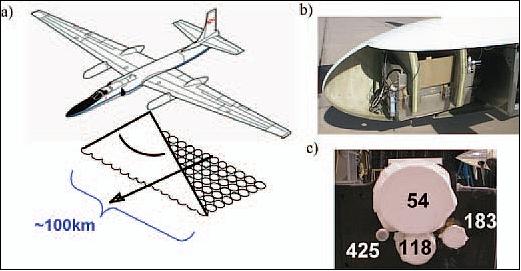
Legend to Figure 1: a) Sketch of NPOESS Aircraft Sounder Testbed (NAST). b) For data collection, the NAST-M sensor is mounted in a wing pod onboard the aircraft. c) NAST-M has four radiometers, as shown.
The NAST-M 54 GHz spectrometer has five channels matching corresponding AMSU-A channels, and the 183 GHz spectrometer has three channels matching corresponding AMSU-B and MHS channels. This spectral coincidence enables direct radiance-to-radiance comparisons, circumventing potential pitfalls and modeling errors that can be introduced when radiosonde or NWP (Numerical Weather Prediction) profiles are used to simulate on-orbit satellite radiometers. Additional NAST-M channels near 118.75 and 424.76 GHz can be used to further improve the fidelity of the radiometric calibration analyses.
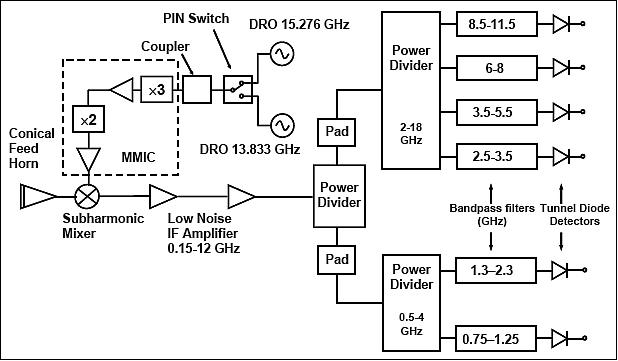
All four of NAST-M’s feedhorns are co-located, and have 3 dB (full-width at half-maximum) beamwidths of 7.5º, which translates to approximately 2.5 km nominal pixel diameter at nadir incidence. The four feedhorns are directed at a single mirror that scans cross-track beneath the aircraft, spanning ± 65º.
The NAST-M sensor package is mounted on an aircraft platform with a typical cruising altitude of 17-20 km, which results in a nominal swath width of 100 km. This high-altitude mobile platform enables good spatial and temporal coincidence with satellite measurements, and NAST-M’s 100 km swath width provides complete coverage of both AMSU and MHS nadir footprints (AMSU-A, AMSU-B, and MHS nadir footprints are 50 km, 15 km, and 15 km, respectively).
NAST-M also flies with additional instrumentation to aid post-collection data analysis. For example, it has a nadir-viewing video camera that collects video images during each flight. These video images can be used later to help assess the cloud levels present at the time of NAST-M data collection. They can also be used to confirm the surface type over which specific data swaths were collected (i.e. land versus ocean).
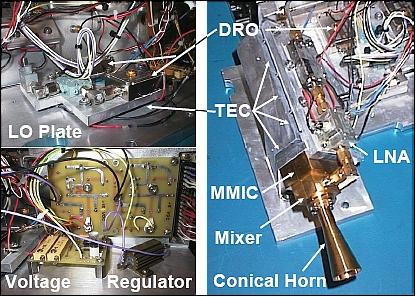
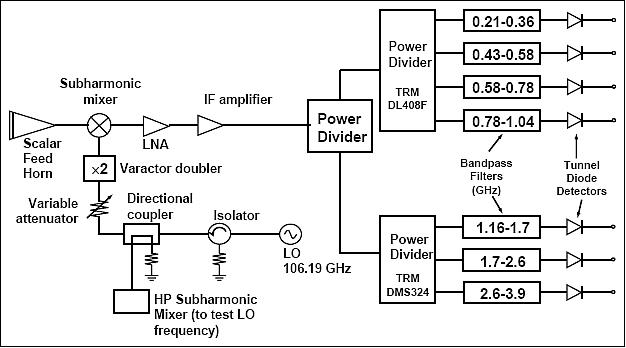
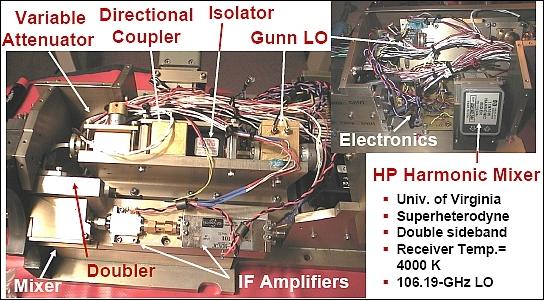
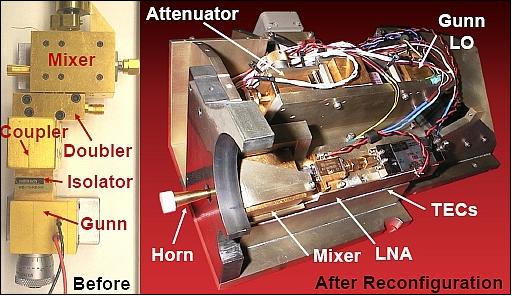
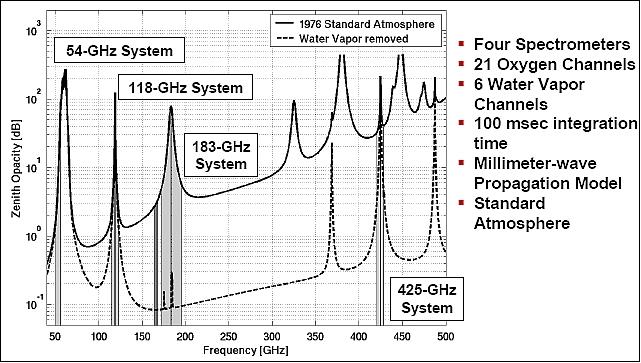
NAST-M calibration: Reliable calibration of NAST-M’s radiometers is essential to its use as a validation sensor. NAST-M observations are calibrated using a three point calibration scheme. As the aircraft flies forward, NAST-M’s internal scanning reflector rotates. With each full rotation, the reflector captures incoming radiation from nadir viewing and three thermal sources of known temperature. The arrangement of scanning reflector with respect to the thermal sources is shown in Figure 8.
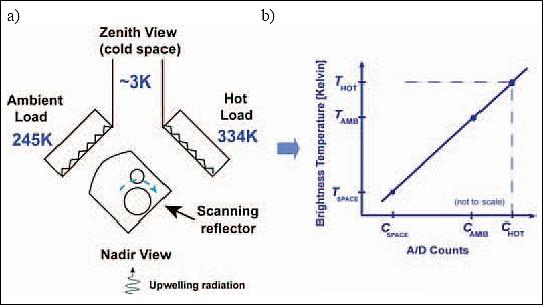
Legend to Figure 8: a) NAST-M reflector and calibration load schematic. Movement of aircraft is into the page. b) Each sweep of the scanning reflector takes data on upwelling target radiation, then three thermal loads of known temperature, which are used to calibrate radiometer counts.
As shown in Figure 9, the NAST-M sensor and satellite fly at significantly different altitudes and each has its own distinctive swath geometry. To address these differences, two types of atmospheric corrections are applied before the satellite and NAST-M datasets are directly compared. First a limb correction is estimated for each sensor’s off-axis footprints using radiative transfer simulations based upon the best atmospheric profile available. This correction accounts for the effects of longer atmospheric path lengths seen by off-nadir footprints, and is generated for and applied to both the satellite and the NAST-M data.
An altitude correction must also be applied to the NAST-M data to correct for atmospheric path length differences due to the difference in altitude between NAST-M and the satellite. This correction is also simulated using the best atmospheric profile available for each dataset’s geographic location and time.
Since both of these simulated corrections are generated based on an atmospheric profile, it is important to use a profile that is as true-to-life as possible. Therefore, a hybrid of dropsonde, radiosonde, and numerical models are sometimes used to compile a best estimate of the atmospheric state at the time and location of data collection.
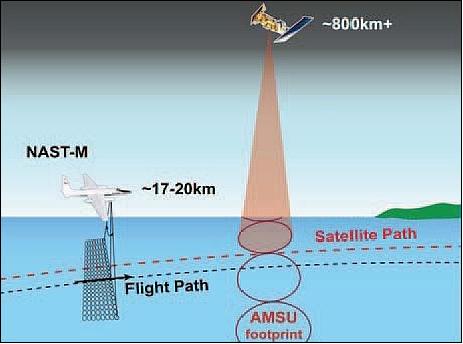
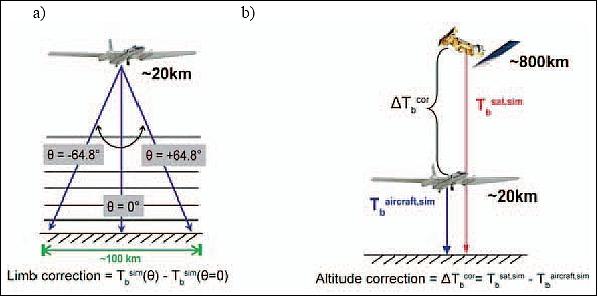
Campaigns
• The PTOST (THORPEX Observing System Test) campaign was conducted out of Honolulu, Hawaii in the early spring of 2003 over the Pacific Ocean (Feb. 18 - March 15, 2003). This campaign included NAST-M underflights of NOAA-16, NOAA-17, and Aqua satellites. PTOST comparisons for AMSU-A and AMSU-B. 12)
Video images were used as a cloud reference during postprocessing of PTOST data. In particular, these images confirmed the presence of clouds during the March 11th, 2003 collection, helping to explain the increased radiometric deviation observed in window channels for that day. For other collections, such as March 12th, the video images confirmed the presence of clear air.
• The JAIVEx (Joint Airborne IASI Validation Experiment) campaign was conducted out of Houston, Texas in the spring of 2007 over the Gulf of Mexico. The objectives of JAIVEx is to validate IASI’s characteristics and quantify its performance so that its observations can best be assimilated into numerical weather prediction models. In addition, JAIVEx provided also comparisons for AMSU-A and MHS sensors on the MetOp-A satellite. The NAST-M data collection on April 20, 2007 was at night, so video data was not helpful in assessing the presence of clouds. 13) 14) 15) 16) 17)
References
1) http://cimss.ssec.wisc.edu/nasti/talks/NASTER_July_2003/Mango_NASTER-I_Meeting_July_10-11_2003.ppt
2) Information provided by A. M. Larar and W. L. Smith of NASA/LaRC
3) W. Smith, A. Larar, D. Zhou, C. Sisko, J. Li, B. Huang, H. Howell, H. Revercomb, D. Cousins, M. Gazarik, D. Money, S. Mango, “NAST-I: Results from Revolutionary Aircraft Sounding Spectrometer,” Proceedings of SPIE, Vol. 3756-28, 1999
4) W. J. Blackwell, J. W. Barrett, P. W. Rosenkranz, M. J. Schwartz, D. H. Staelin, “NPOESS Aircraft Sounder Testbed-Microwave (NAST-M): Instrument Description and Initial Flight Results,” Proceedings of IEEE/IGARSS 2000, Honolulu, HI, July 24-28, 2000
5) W. J. Blackwell, F. W. Chen, R. V. Leslie, P. W. Rosenkranz, M. J. Schwartz, D. H. Staelin, “NPOESS Aircraft Sounder Testbed-Microwave (NAST-M): Results from CAMEX-3 and WINTEX,” Proceedings of IEEE/IGARSS 2000, Honolulu, HI, July 24-28, 2000
6) D. Staelin, F. Chen, “Precipitation observations near 54 and 183 GHz using the NOAA-15 satellite,” IEEE Transactions on Geoscience and Remote Sensing, Vol. 38, 2000, pp. 2322-2332
7) William J. Blackwell, John W. Barrett, Frederick W. Chen, R. Vincent Leslie, Philip W. Rosenkranz, Michael J. Schwartz, David H. Staelin, “NPOESS Aircraft Sounder Testbed-Microwave (NAST-M): Instrument Description and Initial Flight Results,” IEEE Transactions on Geoscience and Remote Sensing, Vol. 39, No 11, Nov. 2001, pp. 2444-2453, URL: http://cimss.ssec.wisc.edu/jaivex/wp-content/uploads/2007/04/nastm_tgars_01_04.pdf
8) R. V. Leslie, J. A. Loparo, P. W. Rosenkranz, D. H. Staelin, “Cloud and Precipitation Observations with the NAST-M Spectrometer Suite at 54/118/183/425 GHz,” Proceedings of IGARSS 2003, Toulouse, France, July 21-25, 2003,
9) R. V. Leslie, W. J. Blackwell, P. W. Rosenkranz, D. H. Staelin, “183 GHz and 425 GHz Passive Microwave Spectrometers on the NPOESS Aircraft Sounder Testbed-Microwave (NAST-M),” Proceedings of IGARSS 2003, Toulouse, France, July 21-25, 2003
10) Laura G. Jairam, Laura J. Bickmeier, William J. Blackwell, R. Vincent Leslie, Fred W. Chen, “Radiometric Validation of Microwave Satellite Instruments using the NPOESS Aircraft Sounder Testbed Microwave (NAST-M) Sensor,” Proceedings of IGARSS 2008 (IEEE International Geoscience & Remote Sensing Symposium), Boston, MA, USA, July 6-11, 2008
11) Michael P. Scarito, “Design and Development of an Airborne Microwave Radiometer for Atmospheric Sensing,” Thesis, MIT, June 21,2011, URL: https://dspace.mit.edu/handle/1721.1/66808
12) http://cimss.ssec.wisc.edu/itwg/itsc/itsc16/posters/B21_William_Blackwell.pdf
13) Stuart Newman, Jonathan Taylor, Fiona Hilton, Andrew Collard, Bill Smith, Allen Larar et aö., “Direct radiance validation of IASI - results from JAIVEx,” ITSC-XVI, Angra dos Reis, Brazil, 7-13 May 2008, URL: http://cimss.ssec.wisc.edu/itwg/itsc/itsc16/presentations/02_08_newman.pdf
14) W. Smith, A. Larar, J.Taylor, H. Revercomb , S. Kireev, D. Zhou, X. Liu, D. Tobin, S. Newman, P. Schluesse, A. Clough, S. Mango, K. St. Germain, “Joint Airborne IASI Validation Experiment (JAIVEx) - An Overview,” URL: http://cimss.ssec.wisc.edu/itwg/itsc/itsc16/proceedings/2_5_SmithSr.pdf
15) Allen Larar, William Smith, Daniel Zhou, Xu Liu, Henry Revercomb, David Tobin, Jonathan Taylor, Peter Schlüssel, Stephen Mango, “The Joint Airborne IASI Validation Experiment (JAIVEx) and select contributions from NAST-I,” 2008, URL: http://npoess.noaa.gov/.../35.NPOESS_Sym_2008_Larar.pdf
16) William Smith Sr., Jonathan Taylor, Allen Larar, Henry Revercomb, “A Preliminary Report to EUMETSAT and the IPO for NPOESS - Initial Results from the Joint Airborne IASI Validation Experiment (JAIVEx),” Houston, TX, April 12, May 4, 2007, URL: http://smsc.cnes.fr/IASI/JAIVEx_Report.pdf
17) Daniel K. Zhou, Xu Liu, Allen M. Larar, William L. Smith, Jonathan P. Talor, Peter Schlüseel, L. Larrabee Strow, Steve Mango, “Inter-comparison between AIRS and IASI through retrieved parameters,” URL: http://ntrs.nasa.gov/archive/nasa/casi.ntrs.nasa.gov/20080037571_2008036972.pdf
The information compiled and edited in this article was provided by Herbert J. Kramer from his documentation of: ”Observation of the Earth and Its Environment: Survey of Missions and Sensors” (Springer Verlag) as well as many other sources after the publication of the 4th edition in 2002. - Comments and corrections to this article are always welcome for further updates (eoportal@symbios.space).